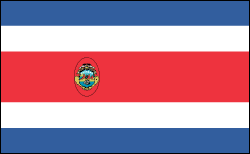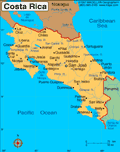Costa Rica | Facts & Information

- Costa Rica Profile
- History
- News and Current Events
Infoplease has everything you need to know about Costa Rica. Check out our country profile, full of essential information about Costa Rica's geography, history, government, economy, population, culture, religion and languages. If that's not enough, click over to our collection of world maps and flags.
Facts & Figures
-
Republic of Costa Rica
President: Luis Guillermo Solís (2014)
Land area: 19,560 sq mi (50,660 sq km); total area: 19,730 sq mi (51,100 sq km)
Population (2014 est.): 4,755,234 (growth rate: 1.24%); birth rate: 16.08/1000; infant mortality rate: 8.7/1000; life expectancy: 78.23
Capital and largest city (2011 est.): San José, 1.515 million
Monetary unit: Colón
National name: República de Costa Rica
Languages: Spanish (official), English
Ethnicity/race: white or mestizo 83.6%, mulato 6.7%, indigenous 2.4%, black of African descent 1.1%, other 1.1%, none 2.9%, unspecified 2.2% (2011 est.)
National Holiday: Independence Day, September 15
Religion: Roman Catholic 76.3%, Evangelical 13.7%, Jehovah's Witnesses 1.3%, other Protestant 0.7%, other 4.8%, none 3.2%
Literacy rate: 96.3% (2011 est.)
Economic summary: GDP/PPP (2013 est.): $61.43 billion; per capita $12,900. Real growth rate: 3.5%. Inflation: 5.6%. Unemployment: 7.9%. Arable land: 4.89%. Agriculture: coffee, pineapples, bananas, sugar, corn, rice, beans, potatoes; beef; timber. Labor force: 2.222 million; agriculture 14%, industry 22%, services 64% (2006 est.). Industries: microprocessors, food processing, textiles and clothing, construction materials, fertilizer, plastic products. Natural resource: hydropower. Exports: $11.66 billion (2013 est.): coffee, bananas, sugar, pineapples; textiles, electronic components, medical equipment. Imports: $17.56 billion (2013 est.): raw materials, consumer goods, capital equipment, petroleum. Major trading partners: U.S., Netherlands, Hong Kong, Nicaragua, Mexico, China (2012).
Communications: Telephones: main lines in use: 1.018 million (2012); mobile cellular: 6.151 million (2012). Broadcast media: multiple privately owned TV stations and 1 publicly owned TV station; cable network services are widely available; more than 100 privately owned radio stations and a public radio network (2007). Internet hosts: 147,258 (2012). Internet users: 1.485 million (2009).
Transportation: Railways: total: 278 km (2008). Roadways: total: 38,049 km; (2010). Waterways: 730 km (seasonally navigable by small craft) (2004). Ports and harbors: Caldera, Puerto Limon. Airports: 161 (2013 est.).
International disputes: Costa Rica and Nicaragua regularly file border dispute cases over the delimitations of the San Juan River and the northern tip of Calero Island to the International Court of Justice (ICJ); in 2009, the ICJ ruled that Costa Rican vessels carrying out police activities could not use the river, but official Costa Rican vessels providing essential services to riverside inhabitants and Costa Rican tourists could travel freely on the river; in 2011, the ICJ provisionally ruled that both countries must remove personnel from the disputed area; in 2013, the ICJ rejected Nicaragua's 2012 suit to halt Costa Rica's construction of a highway paralleling the river on the grounds of irreparable environmental damage; in 2013, the ICJ, regarding the disputed territory, ordered that Nicaragua should refrain from dredging or canal construction and refill and repair damage caused by trenches connecting the river to the Caribbean and upheld its 2010 ruling that Nicaragua must remove all personnel; in early 2014, Costa Rica brought Nicaragua to the ICJ over offshore oil concessions in the disputed region .









